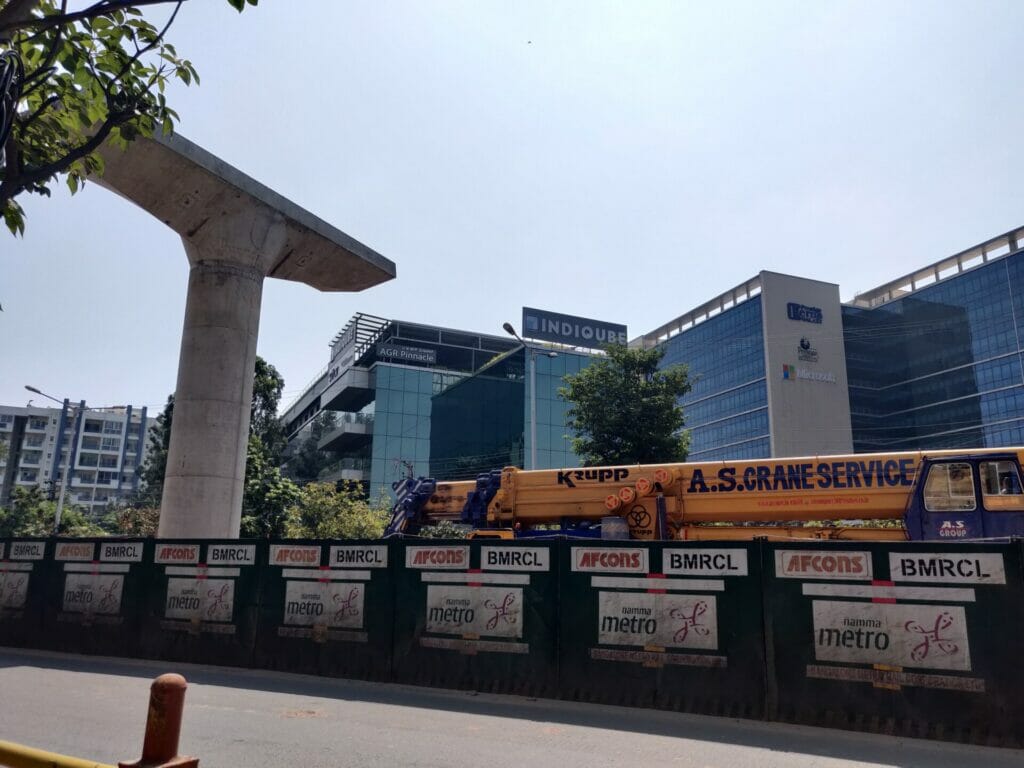Towards the end of 2016, the massive public campaign against the proposed steel flyover, led by Citizens for Bengaluru along with many other groups, not only stopped the Government from building the flyover but also helped build support for improved and better mass public transport in Bengaluru.
Protests against elevated corridor project
The dormant demand for suburban train gathered steam with the energetic #ChukuBukuBeku rail yatra and all major parties pledged funds and professed keen interest in the project. It also became a topic of discussion during the 2018 Assembly and 2019 Lok Sabha elections.
Similarly, the campaign to double the BMTC bus fleet and halve the fares #BusBhagyaBeku brought forth the important role the humble city bus played in our city and kept the fares low despite the massive increase in fuel prices.
But the new coalition government of JDS & Congress formed in 2018 instead tried to bring in a 100km elevated corridor project, which promptly met with protests against the project with thousands of citizens gathering at Maurya circle.
The protest had an almost instant effect, as the then CM, HD Kumaraswamy quickly invited civil society groups for a discussion the very next day. The CM assured that public transport is the top priority and his government will not move forward on the elevated corridors without consultation and scientific assessment.
The project has since been put on the back burner.
Introduction of BMLTA
The single biggest achievement in the last five years is the passing of the long pending Bengaluru Metropolitan Land Transport Authority (BMLTA) Bill.
Lack of regional level planning and coordination among the many different transport service providers was hurting our city. For a mega city like Bengaluru, we need metro, suburban, bus, cycle and walking all to gel together for seamless experience for the commuter. But there was no one with that responsibility. The public campaign #BMLTAbeku last year showed once again that Bengaluru has many individuals and organisations fighting for long term solutions towards sustainable mobility.
Read more: Advice for the next CM: For a better Bengaluru, ensure growth in rest of Karnataka
The biggest policy failure has been the inability of BMTC to hire bus drivers leading to nearly 500+ buses lying idle in depots. This is inexcusable as the commuters returned in droves to BMTC post pandemic and there is a huge demand for bus services in every part of the city. Electric buses have been a welcome addition but the government failed to provide funding support to BMTC in proportion to the service it renders to lakhs of citizens daily.
Public transport in Bengaluru got a major fillip this year with the much-awaited metro line to Whitefield becoming a reality. Though it is common knowledge that most private vehicles are headed to Electronic City, ORR/Sarjapur and Whitefield, our Metro hadn’t reached any of these places until now. We should expect thousands of commuters to ditch their cars and switch to metro, particularly when the missing link between K.R.Puram and Byappanhalli gets completed. Yet another long pending project was the BMTC mobile app. This is now available and is likely to make a difference as bus services become more predictable and reliable for those that want to take the bus but hesitate due to lack of information.
The common mobility card that works across bus and metro is, however, still a distant dream.
Make Bengaluru cyclist and pedestrian-friendly
While there is a lot of enthusiasm for cycling, not enough has been done to create a network for safe cycling and we hope this gets fixed in the next five years.
Bengaluru is best suited for walking as well but our pedestrian infrastructure including footpaths and intersections, need massive investment. Particularly as metro services expand to cover more areas and lakhs of people are going to be within walking distance of metro stations.

After much fanfare and political rhetoric, tens of thousands of crores have been allocated for suburban trains. Unfortunately progress on the ground has been slow. Those of us that lobbied hard for it are further disappointed that instead of leveraging existing lines and coaches, a brand new metro like system is being envisioned with AC coaches etc. Prime Minister Modi set a 40-month deadline but it doesn’t seem to inspire KRIDE, the body set up to build this network. Despite the disappointments, however, it is good to see suburban rail taking shape, slowly but surely.
Ill-conceived flyovers
Bengaluru has the unfortunate distinction of being on top of charts as far as road accidents go, particularly pedestrian fatalities, which are quite alarming – 224 in the last year – highlighting the need for safer streets. The last Karnataka government and BBMP budgets allocated Rs 150 crore for redesigning 75 critical junctions with high incidents of accidents and high volumes of pedestrians. A new project ‘Suraksha 75’ has been launched (Disclaimer: This author is Fellow at WRI-India which is a knowledge partner for BBMP)
Read more: The great election inauguration: State govt capitalises on unfinished, poorly done projects
Another proposed flyover at the Sankey bridge announced close to the end of this five year term saw strong protests from citizen groups and the newly formed BMLTA intervened to put the project on hold. The public response to this flyover, once again showed that active citizens of Bengaluru care deeply about sustainable mobility.
In the next five years, I feel Bengaluru will begin a new chapter with Metro construction gathering momentum and lines to Electronic City, ORR and Airport being commissioned. First and last mile connectivity will also see a lot of improvements as the city becomes metro connected in all directions.
If the political will stays with public transport and not ill-conceived flyovers, Bengaluru should be able to shed the tag of being the most congested city by offering reliable, affordable and safe public transport to all.
They should Build Ejipura-Agra Link Road
#IRR to #ORR
#RoadBeku #LinkingRoadBeku